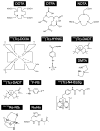Bombesin receptor-mediated imaging and cytotoxicity: review and current status
- PMID: 21034419
- PMCID: PMC3058932
- DOI: 10.2174/156720111793663624
Bombesin receptor-mediated imaging and cytotoxicity: review and current status
Abstract
The three mammalian bombesin (Bn) receptors (gastrin-releasing peptide [GRP] receptor, neuromedin B [NMB] receptor, BRS-3) are one of the classes of G protein-coupled receptors that are most frequently over-express/ectopically expressed by common, important malignancies. Because of the clinical success of somatostatin receptor-mediated imaging and cytotoxicity with neuroendocrine tumors, there is now increasing interest in pursuing a similar approach with Bn receptors. In the last few years then have been more than 200 studies in this area. In the present paper, the in vitro and in vivo results, as well as results of human studies from many of these studies are reviewed and the current state of Bn receptor-mediated imaging or cytotoxicity is discussed. Both Bn receptor-mediated imaging studies as well as Bn receptor-mediated tumoral cytotoxic studies using radioactive and non-radioactive Bn-based ligands are covered.
Conflict of interest statement
Figures


Similar articles
-
Pharmacology and selectivity of various natural and synthetic bombesin related peptide agonists for human and rat bombesin receptors differs.Peptides. 2011 Aug;32(8):1685-99. doi: 10.1016/j.peptides.2011.06.017. Epub 2011 Jun 28. Peptides. 2011. PMID: 21729729 Free PMC article.
-
Ability of various bombesin receptor agonists and antagonists to alter intracellular signaling of the human orphan receptor BRS-3.J Biol Chem. 1998 May 29;273(22):13613-24. doi: 10.1074/jbc.273.22.13613. J Biol Chem. 1998. PMID: 9593699
-
Bombesin related peptides/receptors and their promising therapeutic roles in cancer imaging, targeting and treatment.Expert Opin Ther Targets. 2016 Sep;20(9):1055-73. doi: 10.1517/14728222.2016.1164694. Epub 2016 Mar 28. Expert Opin Ther Targets. 2016. PMID: 26981612 Free PMC article. Review.
-
(68)Ga-labeled bombesin analogs for receptor-mediated imaging.Recent Results Cancer Res. 2013;194:221-56. doi: 10.1007/978-3-642-27994-2_12. Recent Results Cancer Res. 2013. PMID: 22918762 Review.
-
Peptide structural requirements for antagonism differ between the two mammalian bombesin receptor subtypes.J Pharmacol Exp Ther. 1995 Oct;275(1):285-95. J Pharmacol Exp Ther. 1995. PMID: 7562561
Cited by
-
Comparison between 68Ga-bombesin (68Ga-BZH3) and the cRGD tetramer 68Ga-RGD4 studies in an experimental nude rat model with a neuroendocrine pancreatic tumor cell line.EJNMMI Res. 2011 Dec 13;1:34. doi: 10.1186/2191-219X-1-34. EJNMMI Res. 2011. PMID: 22214362 Free PMC article.
-
The future of nuclear medicine imaging of neuroendocrine tumors: on a clear day one might see forever...Eur J Nucl Med Mol Imaging. 2014 Dec;41(12):2189-93. doi: 10.1007/s00259-014-2836-1. Eur J Nucl Med Mol Imaging. 2014. PMID: 25047018 No abstract available.
-
Development and Characterization of a Novel, High-Affinity, Specific, Radiolabeled Ligand for BRS-3 Receptors.J Pharmacol Exp Ther. 2019 Jun;369(3):454-465. doi: 10.1124/jpet.118.255141. Epub 2019 Apr 10. J Pharmacol Exp Ther. 2019. PMID: 30971479 Free PMC article.
-
The Nonpeptide Agonist MK-5046 Functions As an Allosteric Agonist for the Bombesin Receptor Subtype-3.J Pharmacol Exp Ther. 2022 Aug;382(2):66-78. doi: 10.1124/jpet.121.001033. Epub 2022 May 29. J Pharmacol Exp Ther. 2022. PMID: 35644465 Free PMC article.
-
Click-to-Chelate: development of technetium and rhenium-tricarbonyl labeled radiopharmaceuticals.Molecules. 2013 Mar 12;18(3):3206-26. doi: 10.3390/molecules18033206. Molecules. 2013. PMID: 23481882 Free PMC article. Review.
References
-
- Breeman WA, Kwekkeboom DJ, de Blois E, de Jong M, Visser TJ, Krenning EP. Radiolabelled regulatory peptides for imaging and therapy. Anticancer Agents Med Chem. 2007;7:345–357. - PubMed
-
- Tweedle MF. Peptide-targeted diagnostics and radiotherapeutics. Acc Chem Res. 2009;42:958–968. - PubMed
-
- Okarvi SM. Peptide-based radiopharmaceuticals and cytotoxic conjugates: potential tools against cancer. Cancer Treat Rev. 2008;34:13–26. - PubMed
Publication types
MeSH terms
Substances
Grants and funding
LinkOut - more resources
Full Text Sources
Molecular Biology Databases
